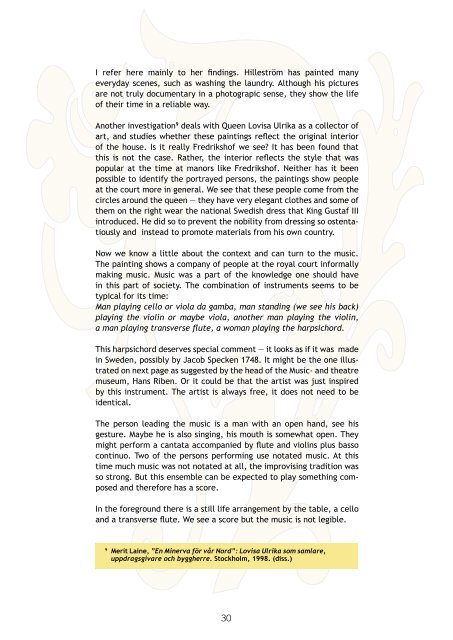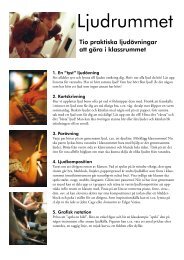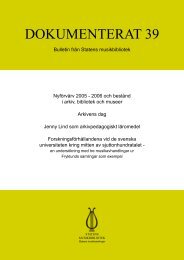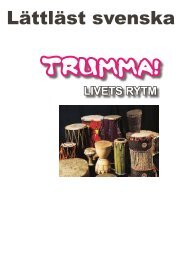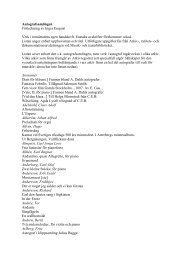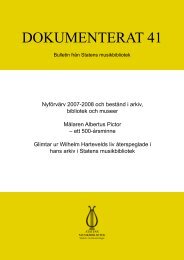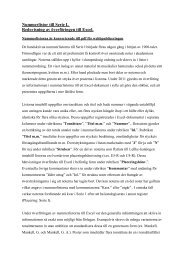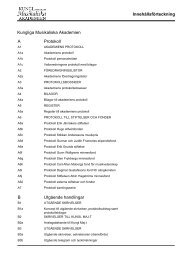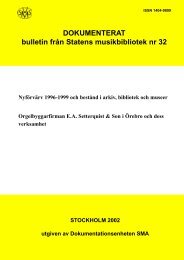Ladda ner (PDF) - Statens musikverk
Ladda ner (PDF) - Statens musikverk
Ladda ner (PDF) - Statens musikverk
Create successful ePaper yourself
Turn your PDF publications into a flip-book with our unique Google optimized e-Paper software.
I refer here mainly to her findings. Hilleström has painted many<br />
everyday scenes, such as washing the laundry. Although his pictures<br />
are not truly documentary in a photograpic sense, they show the life<br />
of their time in a reliable way.<br />
Another investigation 9 deals with Queen Lovisa Ulrika as a collector of<br />
art, and studies whether these paintings reflect the original interior<br />
of the house. Is it really Fredrikshof we see? It has been found that<br />
this is not the case. Rather, the interior reflects the style that was<br />
popular at the time at manors like Fredrikshof. Neither has it been<br />
possible to identify the portrayed persons, the paintings show people<br />
at the court more in ge<strong>ner</strong>al. We see that these people come from the<br />
circles around the queen — they have very elegant clothes and some of<br />
them on the right wear the national Swedish dress that King Gustaf III<br />
introduced. He did so to prevent the nobility from dressing so ostentatiously<br />
and instead to promote materials from his own country.<br />
Now we know a little about the context and can turn to the music.<br />
The painting shows a company of people at the royal court informally<br />
making music. Music was a part of the knowledge one should have<br />
in this part of society. The combination of instruments seems to be<br />
typical for its time:<br />
Man playing cello or viola da gamba, man standing (we see his back)<br />
playing the violin or maybe viola, another man playing the violin,<br />
a man playing transverse flute, a woman playing the harpsichord.<br />
This harpsichord deserves special comment — it looks as if it was made<br />
in Sweden, possibly by Jacob Specken 1748. It might be the one illustrated<br />
on next page as suggested by the head of the Music- and theatre<br />
museum, Hans Riben. Or it could be that the artist was just inspired<br />
by this instrument. The artist is always free, it does not need to be<br />
identical.<br />
The person leading the music is a man with an open hand, see his<br />
gesture. Maybe he is also singing, his mouth is somewhat open. They<br />
might perform a cantata accompanied by flute and violins plus basso<br />
continuo. Two of the persons performing use notated music. At this<br />
time much music was not notated at all, the improvising tradition was<br />
so strong. But this ensemble can be expected to play something composed<br />
and therefore has a score.<br />
In the foreground there is a still life arrangement by the table, a cello<br />
and a transverse flute. We see a score but the music is not legible.<br />
9 Merit Laine, ”En Mi<strong>ner</strong>va för vår Nord”: Lovisa Ulrika som samlare,<br />
uppdragsgivare och byggherre. Stockholm, 1998. (diss.)<br />
30


